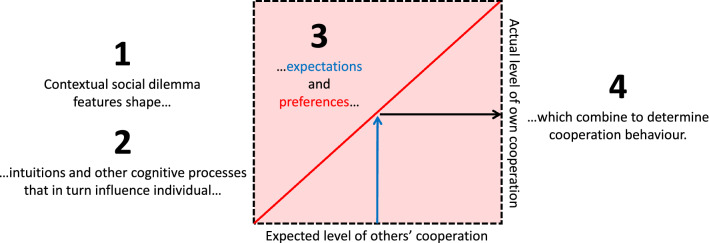Figure 7.
The Contextualised Strong Reciprocity (CSR) account of one-shot cooperation. CSR suggests four steps for explaining why people cooperate in anonymous one-shot social dilemmas: (1) The individual faces a specific decision context involving a social dilemma (e.g., Provision or Maintenance), which (2) shapes intuitions (e.g., social heuristics or selfish impulses) and other cognitive processes (e.g., influencing understanding of incentives, perceptions of social appropriateness of cooperation and the tendency for cognitive reflection). These in turn influence (3) expected cooperation by others (the horizontal axis represents the range of expectations and, for example, the blue arrow represents the expectation that others will contribute half of their endowments) as well as individual preferences for cooperation (the pink area represents the range of possible preferences and, for example, the red line represents the preferences of a perfect conditional cooperator). (4) Actual cooperation behaviour is a function of an individual’s preferences, and in the case of strong reciprocity, also a function of the expected level of cooperation by others (as exemplified by the black arrow). In our studies, evidence for the relationship between steps 1 and 2 is in Figs. 2 and 3; evidence for the relationship between steps 2 and 3 is in Fig. 4; and evidence for the relationship between steps 3 and 4 is in Figs. 5 and 6.

